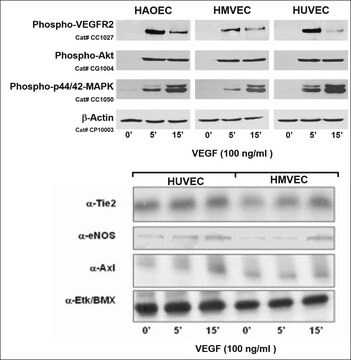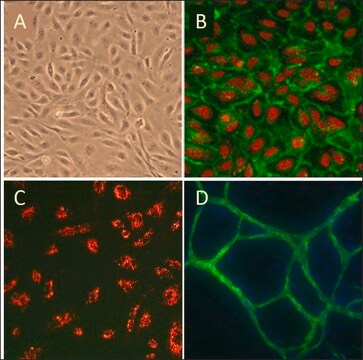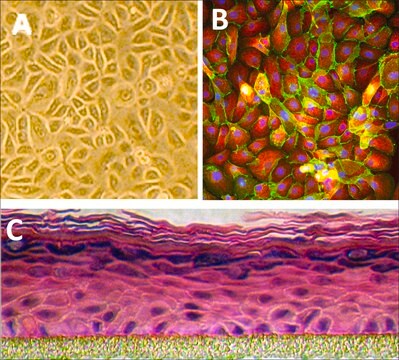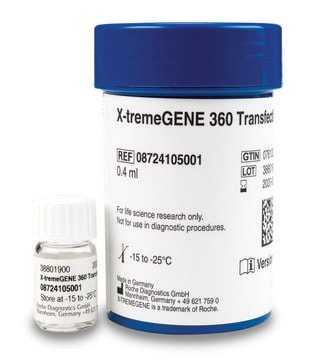200P-05N
Human Umbilical Vein Endothelial Cells: HUVEC, neonatal, pooled
Synonym(s):
HUVEC cells
Sign Into View Organizational & Contract Pricing
All Photos(2)
About This Item
UNSPSC Code:
41106514
NACRES:
NA.81
Recommended Products
biological source
human umbilicus (normal veins)
Quality Level
packaging
pkg of 500,000 cells
manufacturer/tradename
Cell Applications, Inc
growth mode
Adherent
karyotype
2n = 46
morphology
Endothelial
technique(s)
cell culture | mammalian: suitable
relevant disease(s)
arthritis; diabetes; cancer; cardiovascular diseases
shipped in
dry ice
storage temp.
−196°C
Related Categories
General description
Lot specific orders are not able to be placed through the web. Contact your local sales rep for more details.
Human Umbilical Vein Endothelial Cells (HUVEC) provide a classic model system to study many aspects of endothelial function and disease, such as normal, abnormal and tumor-associated angiogenesis, oxidative stress, hypoxia and inflammation related pathways in endothelia under normal and pathological conditions, cardiovascular-related complications associated with various diseases, mode of action and cardiovascular protection effects of various compounds, etc.
Human Umbilical Vein Endothelial Cells (HUVEC) provide a classic model system to study many aspects of endothelial function and disease, such as normal, abnormal and tumor-associated angiogenesis, oxidative stress, hypoxia and inflammation related pathways in endothelia under normal and pathological conditions, cardiovascular-related complications associated with various diseases, mode of action and cardiovascular protection effects of various compounds, etc.
Cell Line Origin
Vein
Application
angiogenesis, cell signaling pathways, migration, invasion, growth factors, tube formation, vascular homeostasis, modulation of blood vessel tone, regulate cell grwoth and ECM deposition, vasculoregulation
Components
Endothelial Cell Basal Medium containing 10% FBS & 10% DMSO
Preparation Note
- Primary culture, >500,000 cells in Endothelial Cell Basal Medium containing 10% FBS & 10% DMSO
- Can be cultured at least 16 doublings
Subculture Routine
Please refer to the HUVEC Culture Protocol.
Disclaimer
RESEARCH USE ONLY. This product is regulated in France when intended to be used for scientific purposes, including for import and export activities (Article L 1211-1 paragraph 2 of the Public Health Code). The purchaser (i.e. enduser) is required to obtain an import authorization from the France Ministry of Research referred in the Article L1245-5-1 II. of Public Health Code. By ordering this product, you are confirming that you have obtained the proper import authorization.
Storage Class Code
11 - Combustible Solids
WGK
WGK 3
Flash Point(F)
Not applicable
Flash Point(C)
Not applicable
Certificates of Analysis (COA)
Search for Certificates of Analysis (COA) by entering the products Lot/Batch Number. Lot and Batch Numbers can be found on a product’s label following the words ‘Lot’ or ‘Batch’.
Already Own This Product?
Find documentation for the products that you have recently purchased in the Document Library.
Justyna Hajtuch et al.
Frontiers in pharmacology, 12, 733743-733743 (2022-02-15)
Purpose: To study and compare the antibacterial properties and the potential cytotoxic effects of commercially available uncoated silver nanoparticles (AgNPs) with lipoic acid coated silver nanoparticles (AgNPsLA) developed by our group. The antibacterial, cytotoxic, and hemolytic properties of those NPs
Marie-Pierre Hardy et al.
Scientific reports, 9(1), 7203-7203 (2019-05-12)
Endothelial cells have multifaceted interactions with the immune system, both as initiators and targets of immune responses. In vivo, apoptotic endothelial cells release two types of extracellular vesicles upon caspase-3 activation: apoptotic bodies and exosome-like nanovesicles (ApoExos). Only ApoExos are
Concepción Santiago-Fernandez et al.
Frontiers in nutrition, 9, 867745-867745 (2022-05-03)
Little is known about the effect of extra virgin olive (EVOO) and sunflower oil (SO) on the composition of extracellular vesicles (EVs) secreted by endothelial cells and the effects of these EVs on smooth muscle cells (SMCs). These cells play
Sara Dutton Sackett et al.
Scientific reports, 8(1), 10452-10452 (2018-07-12)
Extracellular matrix (ECM) plays an important developmental role by regulating cell behaviour through structural and biochemical stimulation. Tissue-specific ECM, attained through decellularization, has been proposed in several strategies for tissue and organ replacement. Decellularization of animal pancreata has been reported
Wenqing Zhou et al.
Journal of cell science, 133(17) (2020-08-14)
Neutrophils rely on glycolysis for energy production. How mitochondria regulate neutrophil function is not fully understood. Here, we report that mitochondrial outer membrane protein Mitofusin 2 (MFN2) regulates neutrophil homeostasis and chemotaxis in vivo Mfn2-deficient neutrophils are released from the
Our team of scientists has experience in all areas of research including Life Science, Material Science, Chemical Synthesis, Chromatography, Analytical and many others.
Contact Technical Service








